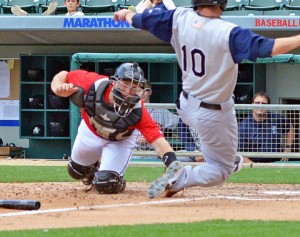
Action will always occur at home plate. It is the job of the Indianapolis Indians catchers, like former Indians Tony Sanchez and Lucas May, to protect the plate at all costs because the whole point of the game is for runners to get home.
The type of home plate collisions such as the one that ruined San Francisco Giants catcher Buster Posey’s 2011 season are few and far between.
Yet, Major League Baseball has agreed on a new rule concerning collisions at the plate. Instead of completely eliminating this aggressive type of play, they attempted to please everyone and amended the rule to avoid cheap shot collisions.
Here in lies the problem – the definition of cheap shot is subjective like the calling of balls and strikes and the new rule doesn’t appear to protecting the players anymore than the previous rule did.
Apparently, determining what a cheap shot is falls in the hands of the umpire. Prior to the new rule, if the catcher blocked the plate and didn’t have or lost possession of the ball the runner was safe. If the catcher maintained possession throughout the collision the runner was out.
The rule was simple – easy to define and call. Now, not so much.
The umpire has to determine whether or not the runner initiated contact with the player covering the plate and/or left the base path to do so. In this situation, the runner is called out. The umpire also has the power to determine if the catcher blocks the plate without possession of the ball and can call the runner safe.
The rule change does nothing and makes the calls more complicated. Managers can disagree with the umpire’s call and can use a challenge to have the play reviewed in the new instant replay options.
It was like MLB was trying to find more ways to use the instant replay in a game that’s never had it before. That’s a whole other story, though.
Let the players and managers get used to having instant replay before initiating the new home plate collision rule.
If the rule change was initiated by Posey’s injury then why does the rule still leave room for these injuries?
Catchers aren’t protected from broken bones and possible concussions. Runners can lose their helmets while colliding with a catcher and ending up injured as well.
The NFL eliminated helmet-to-helmet collisions and received backlash from fans and players. The same sentiment applies to baseball and home plate collisions.
Baseball players aren’t dying from concussions from collisions at home plate. Baseball is so far from a contact sport that collisions at home plate or to break up the double play are the only times players may make contact with another player. There are the occasional brawls and collisions between players going for a fly ball, but those too are few and far between.
The new rule is still on an experimental basis and was brought into practice during Spring Training to allow players and managers to get used to the new rule, but it has yet to be put into action. It’s a waiting game to see what happens throughout the season and if a revision will occur.